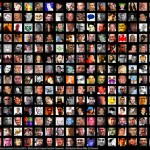 I really, really wanted to title this post “The Short Second Life of Amy Ashmore,” since hanging out in Second Life did in fact feel a lot like a poorly written vampire novel (sorry, Stephenie Meyer). Watching my avatar fly around, I even felt a bit like a vampire – I had become something other than myself (and markedly less human-looking) and was zooming around in a world where no other people seemed to exist.
I really, really wanted to title this post “The Short Second Life of Amy Ashmore,” since hanging out in Second Life did in fact feel a lot like a poorly written vampire novel (sorry, Stephenie Meyer). Watching my avatar fly around, I even felt a bit like a vampire – I had become something other than myself (and markedly less human-looking) and was zooming around in a world where no other people seemed to exist.
I managed to resist the urge, however, (although clearly not the urge to tell you about it), since what I really am interested in is one particular aspect of Second Life: the concept of Information Islands. This spatial metaphor troubles me. Information should not be an island. Ideally, it should be available anywhere, anytime, whenever it is needed. The whole concept of having information seeking be a part of this virtual world suggests (to me) the premise that information should be available anywhere. But by using the concept of information islands, Second Life seems to be reinforcing the idea that information can only be found in certain locations (ie. a library), and that even in a virtual world these locations are physical.
Of course, Second Life is not alone in this – the web is populated with spatial methaphors: websites, postings on walls, dashboards. I guess I was hoping that in an immersive virtual world, we might get away from this, at least when it comes to information. No such luck.
Admittedly, I have absolutely no personal interest in Second Life and would never choose to be in that environment outside of a professional capacity. But even assuming that users were already there, the software and design seems to add steps to accessing information, not remove them. Both times that I went to Info Island, I found it empty. Eerily so. Does that mean the users in Second Life have no information needs? I doubt it. But why manoeuvre yourself all the way over to Info Island when Google is just a browser click away? (I found manoeuvring myself anywhere at all to be a challenge). I’ll pick ease over immersion any time, and judging by the fact that hanging out on Info Island felt like being Tom Hanks in Castaway except with more buildings, I’m guessing other Second Lifers feel the same.
But wait. Moving away from physical spaces. Isn’t this what many librarians are trying to do with information in the real world? I’m not saying there’s no place for the reference desk – after all, I spend my days sitting behind one. But in the real world, users don’t have to go there every time they want to know something. They can email. They can chat. Maybe they can even tweet their information needs. In the real library world, there is certainly a huge push to see the library as more than a physical space. So why replicate the physical space in virtual environments? Now, I realise that providing information services isn’t what Second Life was designed for. But that doesn’t mean there aren’t ways to move beyond these constraints. It’s also possible that there are a whole slew of Second Life information-seeking features I just don’t know about. But I certainly couldn’t find them. So what gives, Second Life? I want to get off this island.
